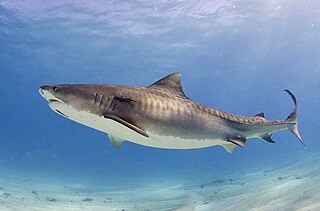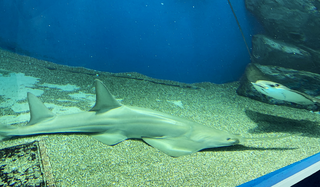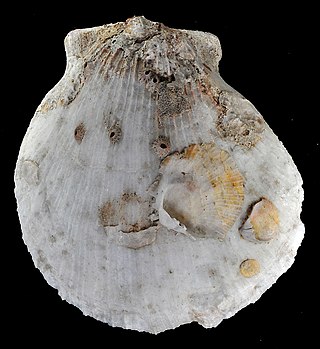
Galeocerdo is a genus of ground shark. Only a single species, G. cuvier, the tiger shark is extant. The earliest fossils date back to the early Eocene epoch, (Ypresian), around 56–47.8 Million years ago. While historically considered a member of the requiem shark family Carcharhinidae, it is currently considered to be the only member of the family Galeocerdonidae. While this genus was historically considered diverse, including 21 extinct species, morphometric analysis conducted in 2021 suggested that the diversity of the genus included only 5 extinct species much lower than previously assumed. The oldest fossils of the extant G. cuvier date to the middle Miocene.

Megophryidae, commonly known as goose frogs, is a large family of frogs native to the warm southeast of Asia, from the Himalayan foothills eastwards, south to Indonesia and the Greater Sunda Islands in Maritime Southeast Asia, and extending to the Philippines. Fossil remains are also known from North America. As of 2014 it encompasses 246 species of frogs divided between five genera. For lack of a better vernacular name, they are commonly called megophryids.

Sawfish, also known as carpenter sharks, are a family of rays characterized by a long, narrow, flattened rostrum, or nose extension, lined with sharp transverse teeth, arranged in a way that resembles a saw. They are among the largest fish with some species reaching lengths of about 7–7.6 m (23–25 ft). They are found worldwide in tropical and subtropical regions in coastal marine and brackish estuarine waters, as well as freshwater rivers and lakes. All species are endangered.

Latimeriidae is the only extant family of coelacanths, an ancient lineage of lobe-finned fish. It contains two extant species in the genus Latimeria, found in deep waters off the coasts of southern Africa and east-central Indonesia. In addition, several fossil genera are known from the Mesozoic of Europe, the Middle East, and the southeastern United States, dating back to the Triassic.

The dwarf sawfish or Queensland sawfish, Pristis clavata, is a sawfish of the family Pristidae, found in tropical Australia. This endangered species is the smallest species in its family.

The largetooth sawfish is a species of sawfish in the family Pristidae. It is found worldwide in tropical and subtropical coastal regions, but also enters freshwater. It has declined drastically and is now critically endangered.

The smalltooth sawfish is a species of sawfish in the family Pristidae. It is found in shallow tropical and subtropical waters in coastal and estuarine parts of the Atlantic. Reports from elsewhere are now believed to be misidentifications of other species of sawfish. It is a critically endangered species that has disappeared from much of its historical range.

The longcomb sawfish, narrowsnout sawfish or green sawfish is a species of sawfish in the family Pristidae, found in tropical and subtropical waters of the Indo-West Pacific. It has declined drastically and is now considered a critically endangered species.

Scolopendridae is a family of large centipedes.

Cycloderma is a genus of softshell turtles in the subfamily Cyclanorbinae of the family Trionychidae. The genus is endemic to Africa.

Epihippus is an extinct genus of the modern horse family Equidae that lived in the Eocene, from 46 to 38 million years ago.
Batrachosaurus is an extinct genus of prehistoric brachyopoid amphibian that lived in Germany during the Middle Triassic (Ladinian). The genus was named by Joseph Fitzinger in 1837 and the type species, B. jaegeri, was named three years later in 1840. It may have been the same animal as Mastodonsaurus.
Batrachosauroides is an extinct genus of prehistoric salamander known from several sites across the United States. The two identified species are Batrachosauroides dissimulans and Batrachosauroides gotoi. A proposed, unidentified third species has been proposed by paleontologist James Gardner based on the discovery of a dental fossil in the Bushy Tailed Blowout area of the Lance Formation fossil grounds, but has not been definitively identified as a new species or as part of either of the two identified species.

Pristis is a genus of sawfish of the family Pristidae. These large fish are found worldwide in tropical and subtropical regions in coastal marine waters, estuaries, and freshwater lakes and rivers. Sawfish have declined drastically and all species are considered critically endangered today.

Chelonoidis is a genus of turtles in the tortoise family erected by Leopold Fitzinger in 1835. They are found in South America and the Galápagos Islands, and formerly had a wide distribution in the West Indies.

Hippohyini was an extinct tribe of Suinae which existed in Asia during the Pliocene.

Pristis lathami is a species of extinct sawfish in the family Pristidae. It lived in the Eocene era, in areas in Egypt, Nigeria, Togo, the United Kingdom, the United States, and Western Sahara, in marine areas, estuaries, bays, open shallow subtidal areas, coastal, marginal marine areas, deep waters, offshore, and fluvial-deltaic areas. P. lathami has 53 occurrences, with 1 being found in Egypt with a rostal tooth about 10 cm in length.
Pristis aquitanicus is an extinct species of sawfish in the family Pristidae. It lived in the Neogene period in France, Portugal, Florida, and India. It lived in marine, bays, and estuaries. It was a nektobenthic carnivore.

Sphodrosaurus is an extinct genus of basal archosauriformn reptiles from the Late Triassic-aged New Oxford Formation of Pennsylvania. The type species is S. pennsylvanicus, described by Edwin Colbert in 1960. The holotype consists of a partial skeleton including the back of the skull, the vertebral column, all of the ribs, all of the hindlimbs and part of the upper forelimbs; Sphodrosaurus was originally believed to have been a member of the Procolophonidae while more recently Sphodrosaurus was believed to be a basal member of the Diapsida by most authors starting with Sues et al. (1993), or a member of the Rhynchosauria. In 2022, Ezcurra & Sues redescribed the holotype in detail and placed it in a phylogenetic analysis with other Triassic diapsid reptiles, where it was found as the basalmost doswellid.

Spondylus candidus is a species of bivalve mollusc within the family Spondylidae. Its distribution covers areas near coasts of Australia and South Africa, and in the Red Sea where it lives in benthic environments at depths of 21 to 75 meters. Fossil occurrences have been found in the Quaternary of Djibouti and in the Miocene of Japan and Vanuatu.















